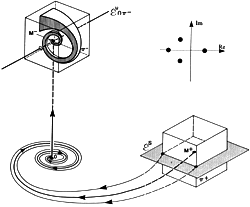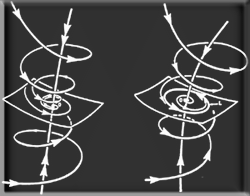|
|
MATH 4275/6275 Applied Dynamical Systems
[Syllabus]
An introduction to discrete and continuous
dynamical systems. Study of nonlinear dynamical systems, leading to chaotic
behavior. Topics include: Phase space. Linear and nonlinear systems. Poincare
maps. Structual stability. Topological conjugacy. Types
of equilibrium states and fixed points. Periodic orbits. Stability. Local bifurcations. Homoclinic
orbits. Routes to chaos. Applications from physics, biology, population
dynamics, economics.
Prerequisites MATH
3260 and 3435
Text L.Shilnikov,
A.Shilnikov, D.Turaev, and L.Chua, Qualitative Methods for Nonlinear Dynamics,
Parts I and II, World Scientific Publ.
Topics Basic
concepts and definitions. Qualitative integration. Linear autonomous systems.
Topological conjugacy. Periodic orbits. Poincare maps and fixed points.
Floquet multipliers. Structural stability. Hyperbolicity. Bifurcations
of equilibrium states and periodic orbits. Invariant tori. Bifurcations
of homoclinic orbits. Smale horseshoe. Routes to chaos and strange attractors.
Applications.
Course requirements Regular homework, 2 tests, and a final exam, which may be replaced by
a project.
Justification The
idea that many simple nonlinear deterministic systems can behave in an
apparently unpredictable and chaotic manner was first noticed by the great
French mathematician Henri Poincare. Other early pioneering work in the
field of chaotic dynamics were found in the mathematical literature by
such luminaries as Birkhoff, Cartwright, Littlewood, Smale, Pontryagin,
Andronov and his students, among others. In spite of this, the importance
of chaos was not fully appreciated until the widespread availability of
digital computers for numerical simulations and the demonstration of chaos
in various real time systems. This realization has broad implications
for many fields of science, and it is only within the past two decades
that the field has undergone explosive growth. It is found that the ideas
of chaos have been very fruitful in such diverse disciplines as biology,
economics, chemistry, engineering, fluid mechanics, and physics.
The field of nonlinear dynamics is very active. Furthermore, there are
numerous applications in the physical and biological sciences, economics,
etc. There are graduate programs in nonlinear dynamics, and there is an
abundance of problems arising from recent subfields, such as the control
of chaos. Courses in the nonlinear sciences would add to both our undergraduate
and graduate programs due to both its timeliness and interesting applications.
Many fascinating phenomena, such as our weather system for example, are
intrinsically nonlinear. This course will provide an introduction to nonlinear
behavior, principally through the study of differential and difference
equations (maps). We will begin with a study of the stability of equilibrium
states, fixed points and periodic orbits of one- and two-dimensional maps.
This can be followed by the study of their bifurcations, and the analysis
of saddle trajectories. This will lead us to emergence of strange attractors
of fractal dimensions; the evolution of saddle orbits into chaos. It will
lead to the idea that seemingly random behavior can emerge from perfectly
deterministic systems. Many of the key ideas can be illustrated by fairly
simple sets of equations that on a computer can be solved rapidly and
accurately.
Nonlinear dynamical systems are used as models in every field of science
and engineering. Universal patters of behavior, including chaos, have
been observed in large sets of examples. Mathematical theories describing
geometrically the qualitative behavior of "generic" systems
explain many of these patterns. This course will discuss dynamical system
theory and its application. Several representative examples from different
disciplines will be described at the beginning of the course and used
throughout the semester to illustrate theoretical ideas. Emphasis will
be placed upon bifurcations, the qualitative changes in solutions of differential
and difference equations that occur as system parameters are varied. Computational
methods for the analysis of dynamical systems will be also discussed.
Examples come from population dynamics (Voltera-Lotka model, period doubling
cascade), physics (van der Pol and Duffing equations) meteorology (Lorenz
model), chemistry (Belousov reaction), finance (low-order stock models,
chaos); and normal forms from mathematics
|
Alternative textbooks and
relevant readings:
[1] Nonlinear Oscillations, Dynamical Systems, and Bifurcations
of Vector Fields, by Guckenheimer J.
and Holmes P.
[2] Elements of Applied Bifurcation Theory, by Kuznetsov Yu., Springer
(1998)
[3] Dynamics and Bifurcations by Hale. J and Kocak, H., Springer
-Verlag (1991)
[4] Introduction to Applied Nonlinear Dynamical Systems and Chaos,
by Wiggins, S. Springer-Verlag (1990)
[5] Chaos in Dynamical Systems, by Ott, E., Cambridge University
Press (1993)
[6] Introduction to chaotic dynamical systems, by Devaney, L., Addison-Wesley
(1989)
[7] Nonlinear Dynamics and Chaos with Applications to Physics, Biology,
Chemistry
and Engineering by Steven H. Strogatz,
Addison Wesley (1994).
[8] CHAOS: An Introduction to Dynamical Systems, by K. Alligood,
T. Sauer, J.A. Yorke, Springer-Verlag
1997
|
|
|


